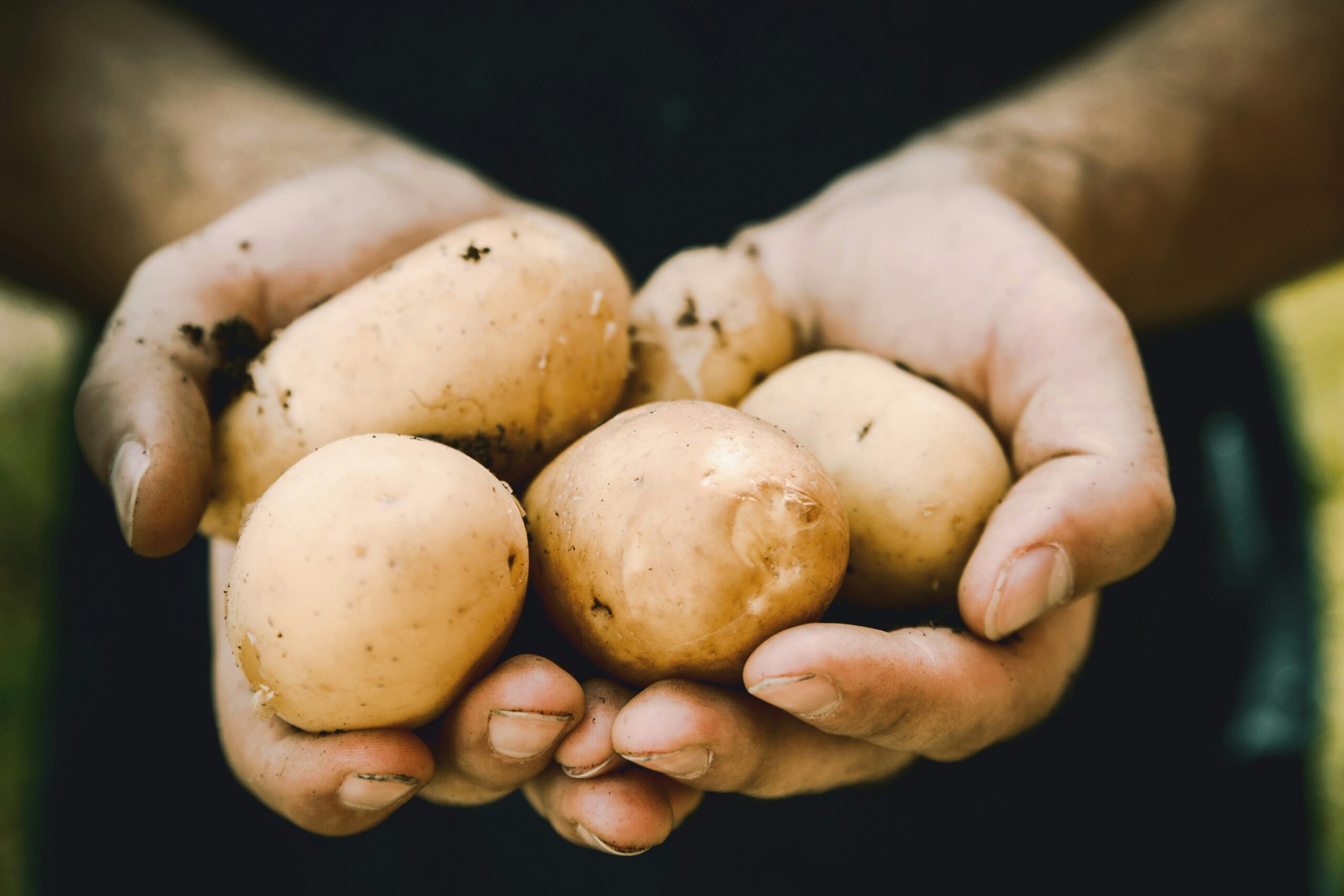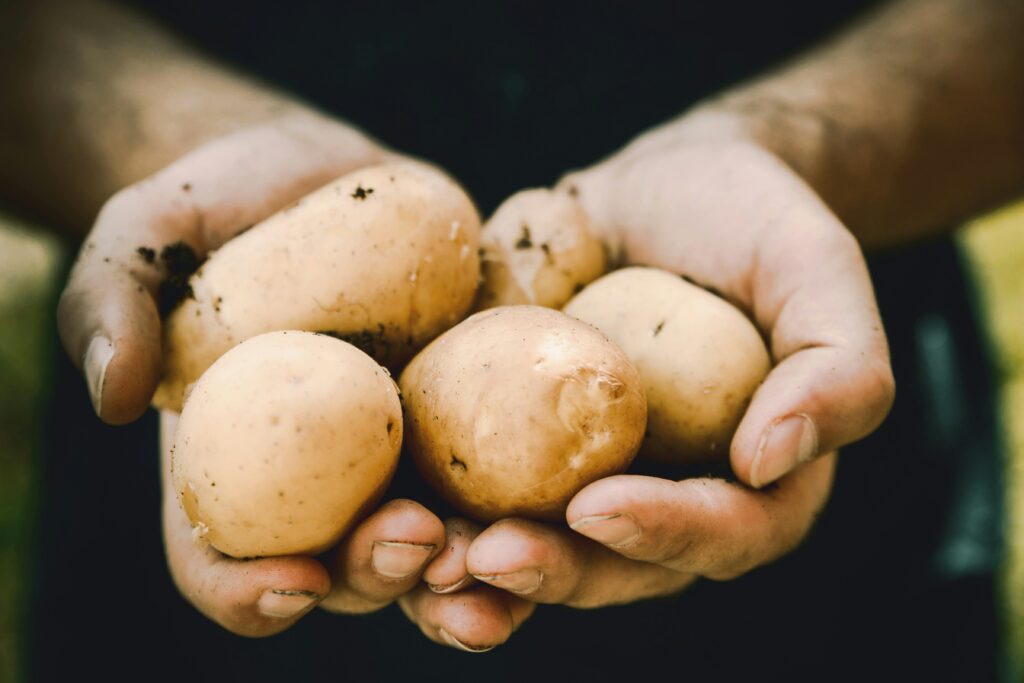
If you want to grow vegetables indoors in buckets, you don’t need a big garden. Most people think of windowsill herbs or salad leaves when they picture indoor food growing. That’s fine for flavour, but not for filling meals. If you’re aiming for genuine self-sufficiency, you need calorie-dense crops like potatoes, beans, and root veg.
The good news? With a few buckets, some compost, and decent light, you can grow these essential foods indoors — even in a small UK flat.
Why Grow Vegetables Indoors in Buckets?
- Space-saving: Ideal for balconies, spare rooms, or utility spaces.
- Self-reliance: Provides meaningful calories, not just garnish.
- Year-round harvests: No need to wait for summer.
- Practice for bigger projects: Buckets are a safe way to learn before scaling up to an allotment.
Which Vegetables Grow Well in Buckets?
Some vegetables are especially suited to confined containers. These are your best bets:
- Potatoes – the highest calorie return per bucket.
- Bush beans – compact, protein-rich, can be eaten fresh or dried.
- Onions and garlic – long shelf life, core ingredients in cooking.
- Root veg – carrots, beetroot, radishes for variety.
- Experiments – grains like barley or wheatgrass; not high-yield but fun for resilience practice.
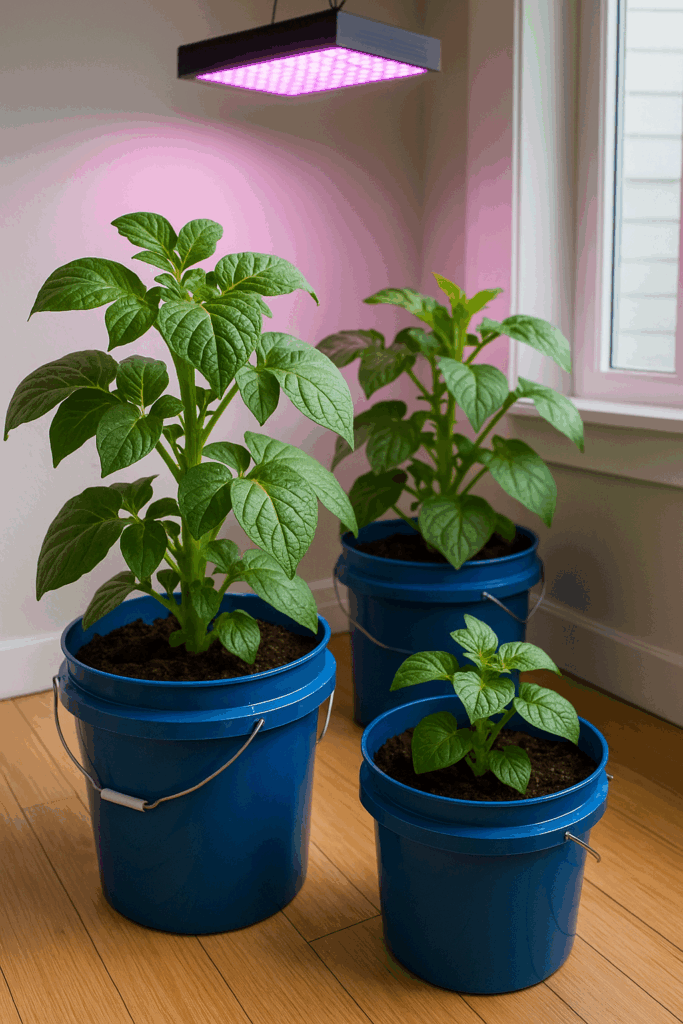
How to Grow Potatoes Indoors in Buckets (Step by Step)
Potatoes are one of the easiest crops when you grow vegetables indoors in buckets, offering the highest calorie return.
- Prepare the bucket
- 10–15 litre container with drainage holes.
- Chit your potatoes
- Let them sprout in a bright, cool place before planting.
- Planting
- Add 10cm of compost, place 2–3 seed potatoes, cover with more compost.
- Hilling
- As plants grow, keep adding compost up the stem. This boosts yield.
- Care
- Light: 6–8 hours per day, grow lights if needed.
- Water: Moist but never waterlogged.
- Harvesting
- When leaves yellow and die back, tip the bucket out and collect your spuds.
Expected yield: 1–2kg per bucket.
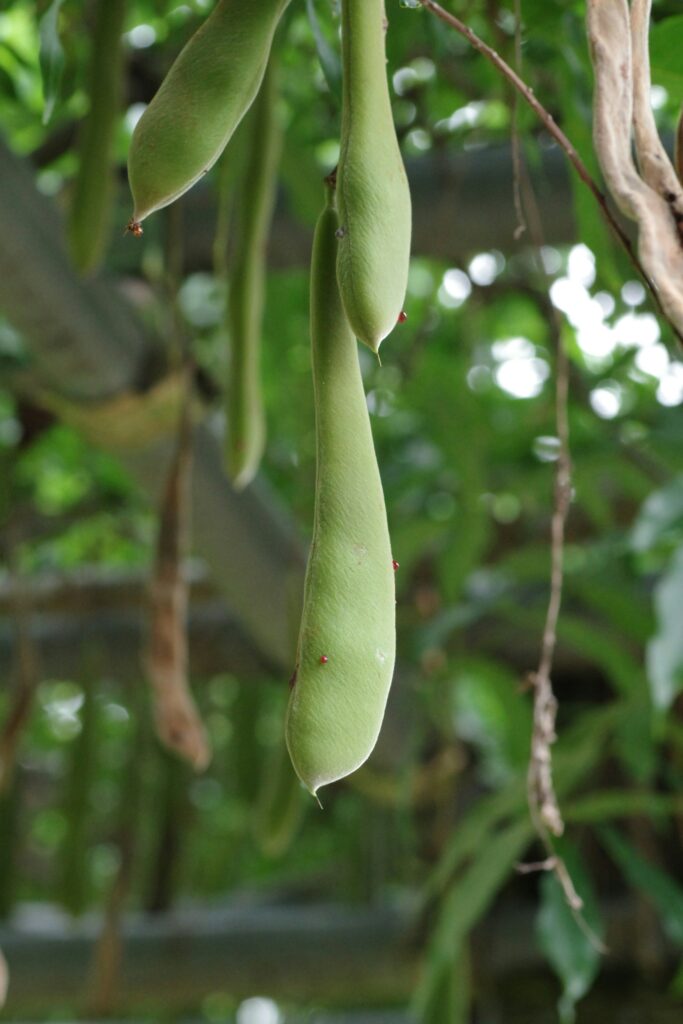
How to Grow Beans Indoors in Buckets
- Choose the right type
- Go for bush or dwarf beans. Climbing beans need too much space indoors.
- Prepare the bucket
- A 15-litre bucket with drainage holes works well.
- Planting
- Sow 4–5 beans evenly spaced in the bucket. Cover with 3–4cm of compost.
- Support
- Add short canes or a small frame. Even bush beans benefit from light support.
- Care
- Light: 8+ hours, or supplement with LEDs. Beans are sun-lovers.
- Water: Keep soil evenly moist; they don’t like drying out.
- Temperature: Aim for 18–24°C; beans sulk if it’s too cold.
- Harvesting
- Fresh pods: pick regularly to encourage more.
- For dried beans: leave pods to mature and dry fully before shelling.
Expected yield: Enough for regular fresh meals; a few hundred grams if dried.
For UK growers aiming to grow vegetables indoors in buckets, beans are a reliable source of protein.
How to Grow Onions and Garlic Indoors in Buckets
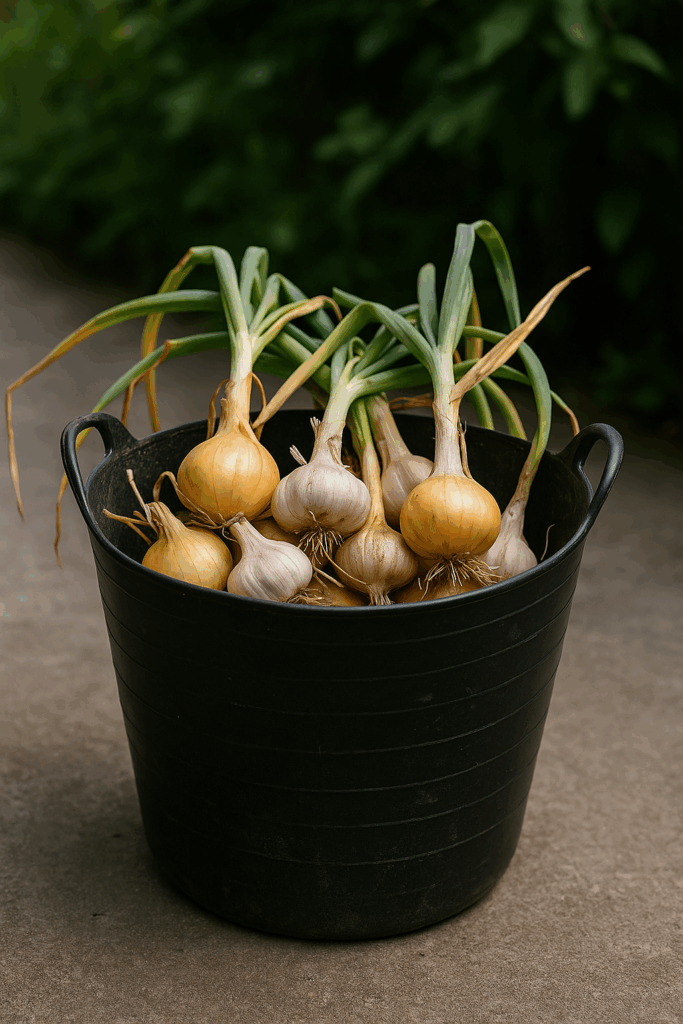
Onions and garlic don’t take up much room, making them perfect if you want to grow vegetables indoor in buckets for long term storage.
- Choose the right crop
- Onions: grow from sets (small immature bulbs).
- Garlic: grow from individual cloves.
- Prepare the bucket
- A shallow but wide container (20–25cm deep) with drainage is best.
- Planting
- Onions: plant sets 10cm apart, just below the soil surface.
- Garlic: plant cloves pointy-end up, 5–7cm deep, spaced 10cm apart.
- Care
- Light: 6–8 hours daily; onions and garlic can tolerate less intense light than beans.
- Water: Keep soil lightly moist; avoid waterlogging.
- Feeding: Occasional liquid feed helps bulb development.
- Harvesting
- Onions: when tops yellow and flop over, bulbs are ready.
- Garlic: harvest when half the leaves have turned brown.
- Storage
- Cure in a dry, airy space. Onions can store for months; garlic can last even longer if kept cool and dry.
Expected yield: A handful of bulbs per bucket — small, but highly valuable for flavour and storage.
How to Grow Carrots, Beetroot, and Radishes Indoors in Buckets
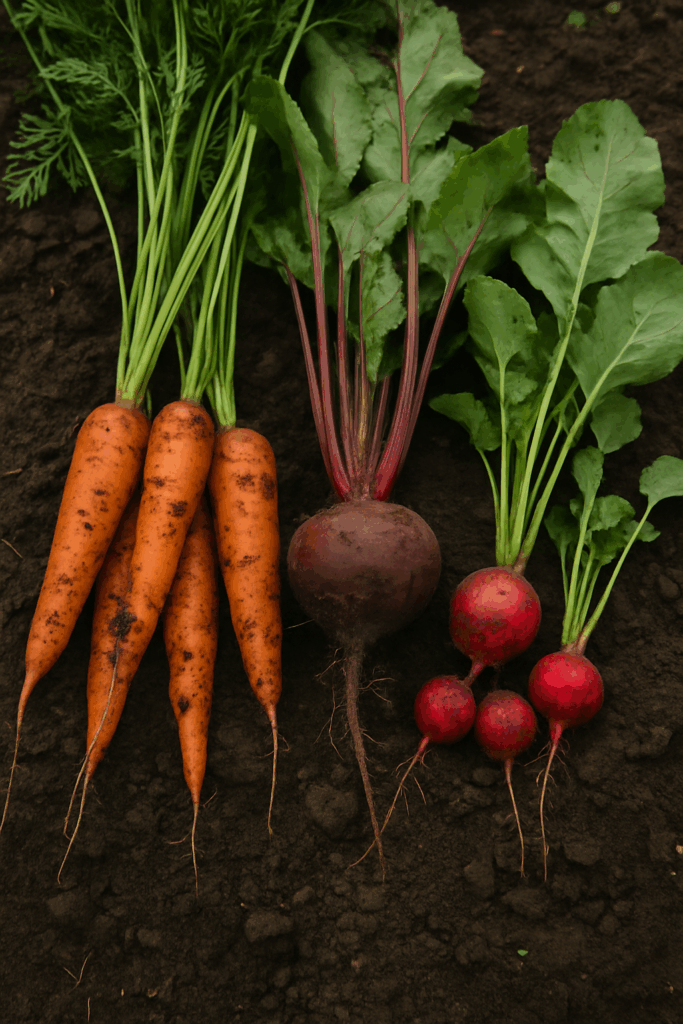
- Choose suitable varieties
- Carrots: go for short-rooted types like Chantenay.
- Beetroot: compact globe varieties.
- Radishes: most types are fast-growing.
- Prepare the bucket
- At least 20–25cm deep with good drainage. Roots need depth.
- Planting
- Sow thinly across the surface, cover lightly with compost.
- Aim to space seedlings about 5cm apart once they’ve sprouted.
- Care
- Light: 6–8 hours daily.
- Water: Keep soil evenly moist; inconsistent watering leads to woody roots or cracks.
- Thinning: Essential for carrots and beetroot; overcrowding reduces yields.
- Harvesting
- Radishes: ready in 3–5 weeks.
- Carrots: usually 8–10 weeks for baby carrots.
- Beetroot: pick young for tender roots, or let mature for bigger yields.
Expected yield: Several meals’ worth per bucket, with radishes as the fastest win.
These root crops add variety when you grow vegetables indoors in buckets, with radishes ready in just a few weeks.
Problems You Might Face When you Grow Vegetables Indoors in buckets(and fixes)
- Low light → Add LED grow lights or reflective foil.
- Too much water → Drill drainage holes; use a saucer to catch excess.
- Limited yields → Remember, this supplements your diet, not replaces outdoor gardening.
- Indoor pests → Fungus gnats and aphids can be managed with sticky traps, neem spray, or by letting soil dry slightly between waterings.
How Much Food Can You Really Expect?
- Potatoes: 1–2kg per bucket.
- Beans: fresh pods throughout summer, or 200–300g dried beans.
- Onions & garlic: a small but useful harvest; stores for months.
- Carrots & beetroot: enough for side dishes; radishes are quick and plentiful.
Conclusion
Buckets aren’t just for carrying water — they’re one of the easiest ways to grow vegetables indoors in buckets and turn limited space into real food.. With potatoes, beans, onions, and roots, you can grow calorie-dense crops indoors that actually add to your meals. For anyone in the UK who wants to be more self-sufficient, bucket growing is an easy, affordable first step.
➡️ Ready to take the next step? Learn about the Best Indoor Grow Lights UK and keep your crops thriving year-round.
💡 Already have grow lights but need help setting them up? Click here to learn about How to Set Up Grow Lights Indoors in the UK – Beginners Guide
Looking for more self-sufficiency and gardening guides? Visit HomeGrower to explore all our latest indoor and outdoor growing tips.
For expert advice check out the RHS website.
FAQs
Can you grow potatoes indoors without sunlight?
Yes, but you’ll need LED grow lights. Potatoes require around 6–8 hours of strong light daily. A full-spectrum grow light can replace natural sunlight.
Which crops give the most calories per bucket?
Potatoes provide the highest calorie return per bucket, followed by beans which also supply protein. Root crops like beetroot and carrots add variety but are less calorie-dense.
How many potatoes from one bucket?
A 15-litre bucket with 2–3 seed potatoes can yield 1–2 kilograms if grown well. Light, water, and compost quality all affect yield.
Can you reuse the compost?
Yes, but it’s best to refresh compost with organic matter before replanting. Avoid planting the same crop immediately in the same soil to reduce pests and disease risk.
What’s the easiest crop to start with?
Potatoes are the easiest bucket crop for beginners because they’re forgiving and productive. Radishes are also good as a fast, simple crop that’s ready in weeks.
For
